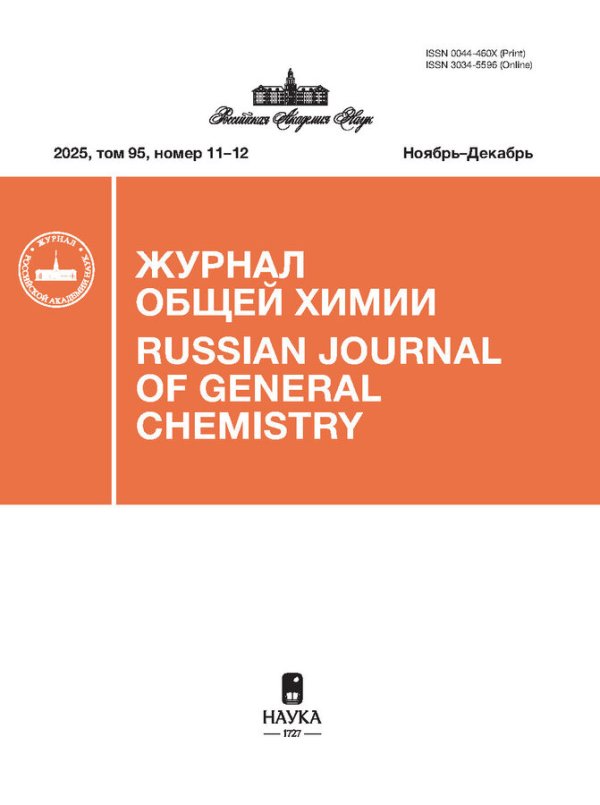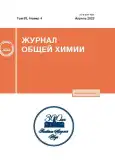Synthesis and study of dense materials in the Zr–Al–C system
- Authors: Arlashkin I.E1,2, Perevislov S.N2, Stolyarova V.L2,3
-
Affiliations:
- St. Petersburg State Institute of Technology (Technical University)
- I.V. Grebenshchikov Institute of Silicate Chemistry of the Russian Academy of Sciences
- St. Petersburg State University
- Issue: Vol 93, No 4 (2023)
- Pages: 622-627
- Section: Articles
- URL: https://journals.rcsi.science/0044-460X/article/view/145025
- DOI: https://doi.org/10.31857/S0044460X23040145
- EDN: https://elibrary.ru/AVSRFC
- ID: 145025
Cite item
Full Text
Abstract
About the authors
I. E Arlashkin
St. Petersburg State Institute of Technology (Technical University);I.V. Grebenshchikov Institute of Silicate Chemistry of the Russian Academy of Sciences
Email: iarlashkin@mail.ru
S. N Perevislov
I.V. Grebenshchikov Institute of Silicate Chemistry of the Russian Academy of Sciences
V. L Stolyarova
I.V. Grebenshchikov Institute of Silicate Chemistry of the Russian Academy of Sciences;St. Petersburg State University
References
- Медведева Н.И., Еняшин А.Н., Ивановский А.Л. // ЖCХ. 2011. Т. 52. № 4. С. 806
- Medvedeva N.I., Enyashin A.N., Ivanovskii A.L. // J. Struct. Chem. 2011. Vol. 52. P. 785. doi: 10.1134/S0022476611040226
- Barsoum M.W. // Progress Solid State Chem. 2000. Vol. 28. N 1-4. P. 201. doi: 10.1016/S0079-6786(00)00006-6
- Istomin P.V., Nadutkin A.V., Ryabkov Y.I., Goldin B.A. // Inorg. Mater. 2006. Vol. 42. N 3. P. 250. doi: 10.1134/S0020168506030071
- Zhang Z.F., Sun Z.M., Hashimoto H. // Mater. Lett. 2003. Vol. 57. N 7. P. 1295. doi: 10.1016/S0167-577X(02)00974-6
- El-Raghy T., Barsoum M.W. // J. Am. Ceram. Soc. 1999. Vol. 82. N 10. P. 2849. doi: 10.1111/j.1151-2916.1999.tb02166.x
- Gao N.F., Miyamoto Y., Zhang D. // J. Mater. Sci. 1999. Vol. 34. N 18. P. 4385. doi: 10.1023/A:1004664500254
- Jeitschko W., Nowotny H., Benesovsky F. // Monatsh. Chem. 1964. Vol. 95. N 1. P. 178. doi: 10.1007/BF00913068
- Perevislov S.N., Sokolova T.V., Stolyarova V.L. // Mater. Chem. Phys. 2021. Vol. 267. P. 124625. doi: 10.1016/j.matchemphys.2021.124625
- Bykova A.D., Semenova V.V., Perevislov S.N., Markov M.A. // Refract. Ind. Ceram. 2021. Р. 89. doi: 10.1007/s11148-021-00564-x
- Перевислов С.Н., Семенова В.В., Лысенков А.С. // ЖНХ. 2021. Т. 66. № 8. С. 987
- Perevislov S.N., Semenova V.V., Lysenkov A.S. // Russ. J. Inorg. Chem. 2021. Vol. 66. N 8. Р. 1100. doi: 10.1134/S0036023621080210
- Perevislov S.N., Arlashkin I.E., Lysenkov A.S. // Refract. Ind. Ceram. 2022. P. 215. doi: 10.1007/s11148-022-00709-6
- Lapauw T., Lambrinou K., Cabioc'h T., Halim J., Lu J., Pesach A., Rivinf O., Ozeri O., Caspi E.N., Hultman L., Eklund P., Rosén J., Barsoum M.W., Vleugels J. // J. Eur. Ceram. Soc. 2016. Vol. 36. N 8. P. 1847. doi: 10.1016/j.jeurceramsoc.2016.02.044
- Lapauw T., Halim J., Lu J., Cabioc'h T., Hultman L., Barsoum M.W., Lambrinou K., Vleugels J. // J. Eur. Ceram. Soc. 2016. Vol. 36. N 3. P. 943. doi: 10.1016/j.jeurceramsoc.2015.10.011
- Okamoto H. // J. Phase Equilib. Diff. 2002. Vol. 23. N 5. P. 455. doi: 10.1361/105497102770331497
- Wang T., Jin Z., Zhao J.C. // J. Phase Equilib. 2001. Vol. 22. N 5. P. 544. doi: 10.1007/s11669-001-0072-4
Supplementary files










